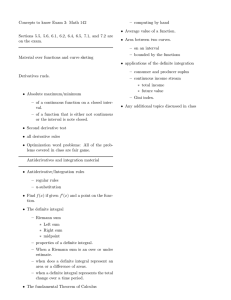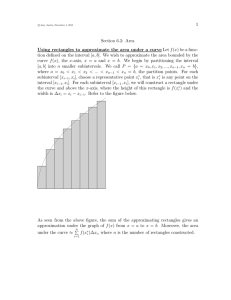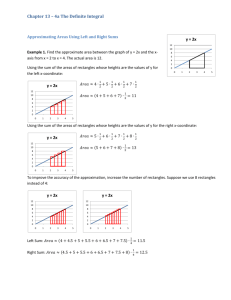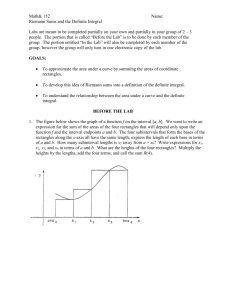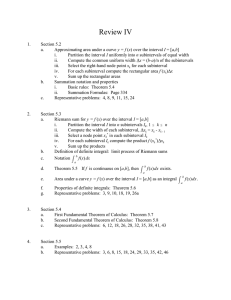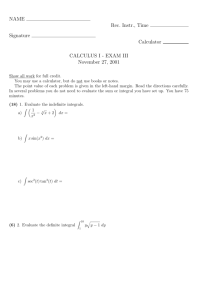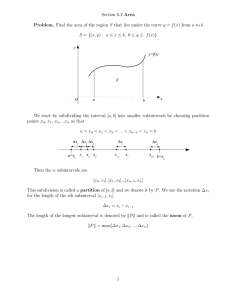MATH 151 Engineering Math I, Spring 2014 JD Kim Week14 Section 6.2 Area
advertisement
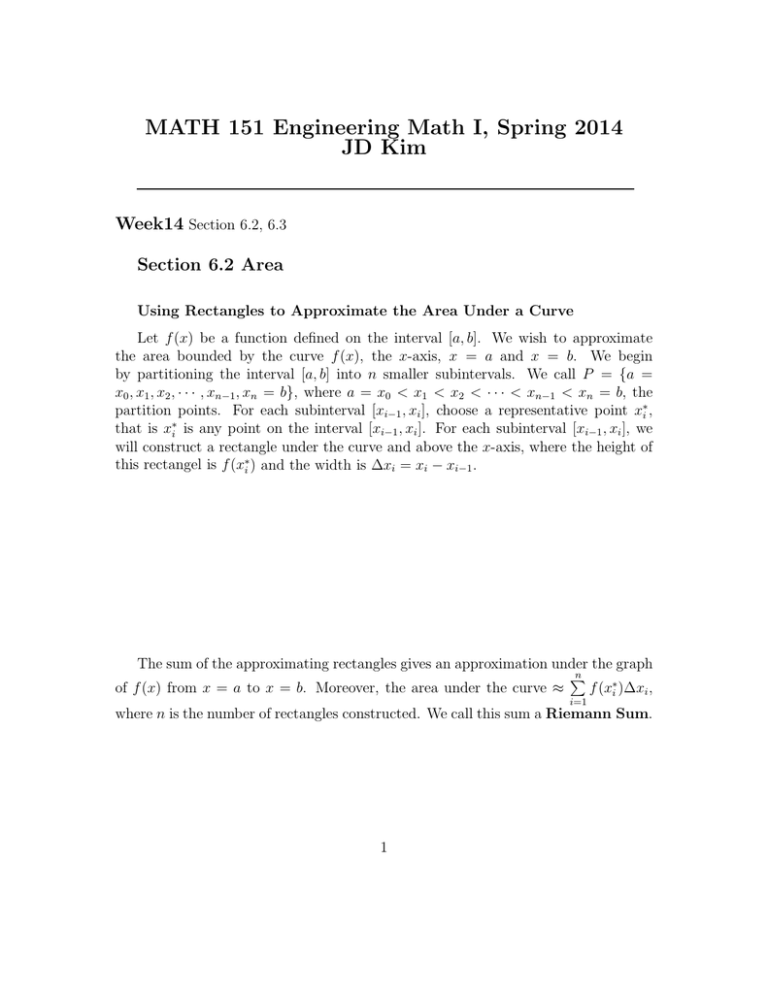
MATH 151 Engineering Math I, Spring 2014
JD Kim
Week14 Section 6.2, 6.3
Section 6.2 Area
Using Rectangles to Approximate the Area Under a Curve
Let f (x) be a function defined on the interval [a, b]. We wish to approximate
the area bounded by the curve f (x), the x-axis, x = a and x = b. We begin
by partitioning the interval [a, b] into n smaller subintervals. We call P = {a =
x0 , x1 , x2 , · · · , xn−1 , xn = b}, where a = x0 < x1 < x2 < · · · < xn−1 < xn = b, the
partition points. For each subinterval [xi−1 , xi ], choose a representative point x∗i ,
that is x∗i is any point on the interval [xi−1 , xi ]. For each subinterval [xi−1 , xi ], we
will construct a rectangle under the curve and above the x-axis, where the height of
this rectangel is f (x∗i ) and the width is ∆xi = xi − xi−1 .
The sum of the approximating rectangles gives an approximation under the graph
n
P
f (x∗i )∆xi ,
of f (x) from x = a to x = b. Moreover, the area under the curve ≈
i=1
where n is the number of rectangles constructed. We call this sum a Riemann Sum.
1
Summary
Subdividing the interval [a, b] into n smaller subintervals
a = x0 < x1 < x2 < · · · < xn−1 < xn = b.
Then the n subintervals are
[x0 , x1 ], [x1 , x2 ], · · · , [xn−1 , xn ].
This subdivision is called a Partition of [a, b].
∆xi = xi − xi−1
is the length of the ith subinterval [xi−1 , xi ].
The length of the longest subinterval is denoted by ||p|| and is called the norm of p,
||p|| = max{∆x1 , ∆x2 , · · · , ∆xn }.
We define the area A as the limiting values (if it exists) of the areas of the approximating polygons,
n
X
A = lim
f (x∗i )∆xi
||p||→0
i=1
2
x∗i
Ex1) A function f , an interval, partition points, and a description of the point
within the ith subinterval are given,
1. Find ||p||.
2. Sketch the graph of f and the approximating rectangles.
3. Find the sum of the approximating rectangles.
1-1) f (x) = 16 − x2 ,
1-2) f (x) = 4 cos x,
[0, 4],
p = {0, 1, 2, 3, 4},
h πi
0,
,
2
x∗i = left endpoint.
n π π π πo
p = 0, , , ,
,
6 4 3 2
3
x∗i = right endpoint
Ex2) For the following functions set up the limit of a Riemann Sum that represents
the area under the graph of f (x) on the given interval. Do not evaluate the limit!.
2-1) f (x) = x2 + 3x − 2 on the interval [1, 4] using right endpoints.
2-2) f (x) =
√
x2 + 1 on the interval [0, 5] using right endpoints.
4
Ex3) The following limits represent the area under the graph of f (x) from x = a
to x = b. Identify f (x), a, and b.
r
n
3
3P
1+ i
3-1) lim
n→∞ n i=1
n
n
10 P
n→∞ n i=1
3-2) lim
1
3
10
1+ 7+ i
n
5
Section 6.3 The Definite Integral
If f (x) ≥ 0 on the interval [a, b], the area under the curve of f (x), above the
n
P
x-axis, from x = a to x = b is ≈
f (x∗i )∆xi . We call this sum a Riemann Sum.
i=1
Ex4) If f (x) = x + x2 , the interval [0, 4], partition points p = {0, 1, 2, 3, 4}, and
x∗i is left endpoint. Find the Riemann sum.
If f (x) ≥ 0 on the interval [a, b], then the true area under the graph of f (x) from
n
P
b−a
and x∗i is any point on
f (x∗i )∆xi , where ∆xi =
x = a to x = b is A = lim
n→∞ i=1
n
the ith subinterval. We would like to define the limit of a Riemann Sum irregardless
of whether the function is positive. To that end, we will define the definite integral.
Definition The Definite Integral
The Definite Integral of f (x) from x = a to x = b is
Z
a
b
f (x)dx = lim
x→∞
n
X
f (x∗i )∆x
i=1
b−a
and x∗i is any point on the ith subinterval. In the event f (x)
n
is positive on the interval [a, b], then the definite integral is the same as the area
bounded by f (x), the x-axis, x = a and x = b. If f (x) is not always positive on the
interval [a, b], then the definite integral is the net area.
where ∆x =
6
Remark Any Riemann Sum can approximate a definite integral. Specifically,
the Midpoint Rule can be used to approximate the definite integral.
Midpoint Rule
Z
a
where ∆x =
b
f (x)dx ≈
n
X
f (x̄i )∆x,
i=1
b−a
and x̄i is the midpoint of the ith subinterval.
n
Ex5) Use the Midpoint Rule with n = 4 to approximate
Ex6) Use Geometry to evaluate the following integrals.
R3
6-1) 0 (1 − 2x)dx
7
R5√
1
x2 + 1dx.
6-2)
6-3)
R3
−1
|x − 2|dx
R0 √
−2
4 − x2 dx
8
Theorem
1.
Z
b
c dx = c(b − a)
a
2.
Z
b
cf (x) dx = c
a
3.
Z
b
f (x) dx
a
b
a
Z
(f (x) ± g(x)) dx =
4.
Z
Z
b
a
f (x) dx ±
Z
b
g(x) dx
a
a
f (x) dx = 0
a
5.
6.
Z
Z
b
a
f (x) dx = −
b
f (x) dx =
a
Z
Z
a
f (x) dx
b
c
f (x) dx +
a
Z
b
f (x) dx
c
7. If m ≤ f (x) ≤ M for all x in the interval [a, b], then
m(b − a) ≤
Z
a
b
f (x) dx ≤ M(b − a)
9
Ex7) Find
Ex8) If
R3
1
R1√
1
x5 + x2 + 1 dx
f (x) dx = 4 and
Ex9) Write
R5
f (x) dx −
−3
R3
1
g(x) dx = −3, find
R0
f (x) dx +
−3
R6
5
Ex10) Find an upper and lower bound on
10
R3
1
(f (x) + 2g(x)) dx.
f (x) dx as a single integral.
R2√
0
x3 + 1 dx
Ex11) Express the following limits as a definite integral
n
1P
n→∞ n i=1
11-1) lim
1
2
i
1+
n
!
5
n
2i
2P
3 1+
−6
11-2) lim
n→∞ n i=1
n
11

